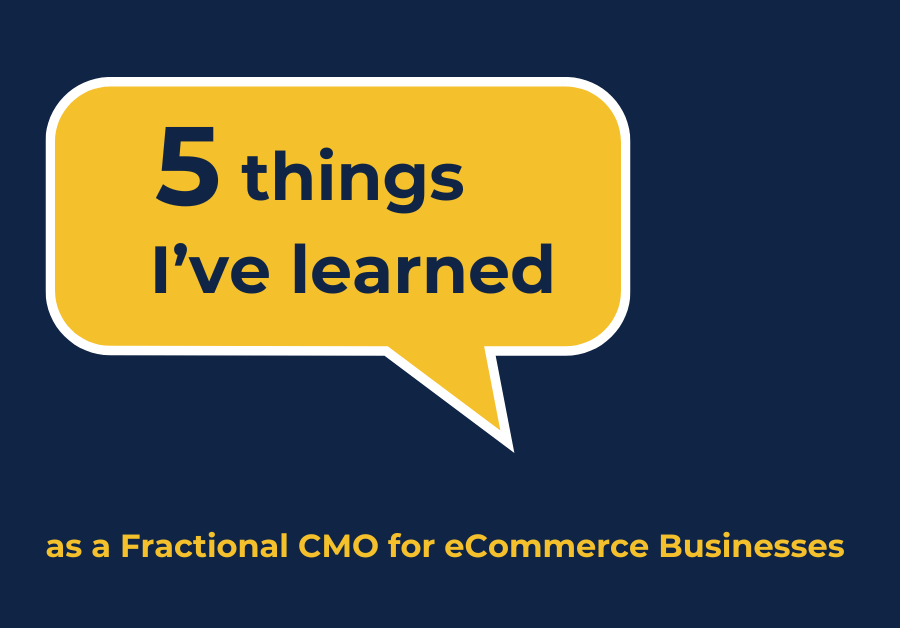I recently received an invitation to be interviewed on a podcast about being a fractional Chief Marketing Officer (CMO), which has had me reflecting on my career. Even with 20+ years of digital marketing experience, I still learn something new from each eCommerce business I work with. In fact, part of the beauty of bringing on fractional leadership is having that learning applied to your business.
In this post, I’ll be sharing some of the insights I’ve gained along my journey. Whether you’re a marketer thinking about offering fractional CMO services or you’re a business owner weighing the benefits of an on-demand marketing leader, here are five things to keep in mind.
- A lot of eCommerce business owners are unintentionally flying blind.
When I start any engagement, diving into the client’s reporting tools is typically the first step. In my experience, the majority of eCommerce business owners are using one-size-fits-all marketing analytics solutions.
Often, conversions aren’t being tracked properly and there is a never-ending flow of reports and data with no real clarity. This means business owners are making decisions based on information that isn’t a reflection of what’s actually going on.
After performing an in-depth audit, I build a custom, interactive marketing dashboard in Google Looker Studio (formerly Google Data Studio), complete with benchmarks based on the client’s goals. From there, the business owner gets the information they need in a way that’s easy to interpret and act on.
- Successful engagements are built on transparency and trust.
If you’re a business owner who wants to make the most out of a fractional CMO engagement, of course, sharing strategy and industry insights is important. After all, the piece that a fractional CMO can’t bring to the picture is industry expertise.
Another factor is believing in marketing and trusting the CMO’s strategy. If you’re white-knuckling your way through campaigns and don’t think they’ll work, ultimately, they probably won’t work.
That said, trust is a two-way street. I practice complete transparency and I never sugarcoat things. I share the why behind tactics and keep clients updated on the results and optimizations. This creates the kind of partnership that leads to exceptional outcomes.
- Investing in relationships with internal team members is key.
When you walk into a company that already has people working in marketing, being responsive and collaborative goes far. Having spent a decade on the corporate side managing internal marketing efforts, I can understand how a client’s existing team may be feeling when I show up.
That’s why as a fractional CMO, I’m respectful of boundaries and focus on doing what I was hired to do without encroaching on anyone else’s role. I also ask instead of tell and take the time to invest in relationships upfront. Having buy-in and support from employees makes for a much smoother path forward.
- Tightening up the ship benefits everyone.
On the flip side, if you’re an employee at a company that is hiring a fractional CMO, know that it’s normal to feel a little apprehensive. And, yes, there will be some changes.
First and foremost, any fractional CMO will want to standardize reporting and help the business become more numbers-centric. I also frequently create standard operating procedures (SOPs) and translate them into repeatable workflows.
By tightening up the ship and organizing processes, a fractional CMO will help you be more effective in your job because things won’t be so ad hoc. When you always know what to do next and have data to guide your decisions, it empowers you to think more creatively and strategically.
- Long-term relationships maximize creative power.
How long should a fractional CMO engagement last? I’ve found that at least a year is the sweet spot. At that point, I’ve been through the cadence of a full editorial calendar and understand the seasonal nuances of a business.
Hiring a fractional CMO for a month or two is like buying a cupcake and not getting the icing. Magic happens over the long run. The first three months of any engagement are a sprint and most of the time is spent understanding the business, cleaning up reporting and processes, and creating the foundation for success.
Once the marketing ecosystem is running smoothly, then creative marketing can start. Truly, the best ideas happen eight to 10 months out. The end date should be when your fractional CMO has run out of ideas and things feel stale and complacent or aren’t moving the needle.
The exception to this rule is when the objective is to grow the business enough to build an internal team. In that scenario, a short-term engagement with a specified end date works well. I come in, create a strategy, and put the internal system in place to execute it. Then, I hand the reins over to you.
Otherwise, I believe a marathon, and not a sprint, is the way to bring out the best in a fractional CMO.
Get strategic marketing leadership for your eCommerce business without a full-time commitment
If you’re looking for a fractional CMO to help you scale your online store sales, book a consultation. Let’s see if we can build something together!

